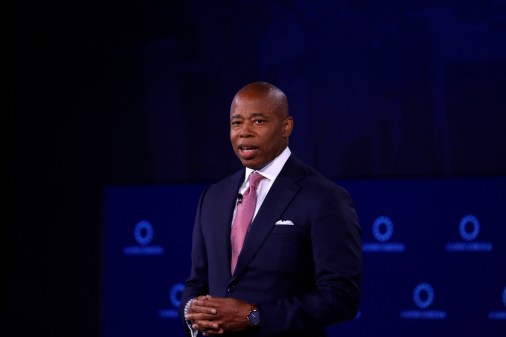LinkNYC: Wi-Fi kiosks delayed in city’s poorer boroughs

New York City now boasts hundreds of LinkNYC kiosks that provide free Wi-Fi service — with more on the way — but one city lawmaker shared concerns that low-income neighborhoods are getting left behind.
Councilmember Jimmy Vacca held a hearing on the issue Tuesday as part of his Committee on Technology, pressing city IT leaders and their private sector partners for more details on their timetable for installing at least 7,500 kiosks by 2024.
While Vacca praised the project for how it “continues to level the playing field” and get New Yorkers better internet access, he also expressed worry that Manhattan enjoys an outsized advantage.
“Right now, we have more kiosks in Manhattan than in the other four boroughs combined, and that is inequitable and unfair,” Vacca said. “Many of these kiosks are in high-end neighborhoods that have access to Wi-Fi, but in neighborhoods that are poorer or middle income, they may never see these kiosks, or may see them 12 years from now.”
The city’s Department of Information Technology & Telecommunications oversees LinkNYC, while CityBridge — a group of tech companies including Qualcomm and Civiq Smartscapes — assumes responsibility for installation of the kiosks in exchange for the advertising revenue generated by the project. That bargain may be letting the city offer the service at no cost to taxpayers, but Vacca said those profit incentives — not concerns of equity — are guiding CityBridge’s involvement in the project.
“The rationale is that people in higher income neighborhoods with more money will see those advertisements and spend money on those products, while people in poorer neighborhoods in the outer boroughs don’t have that disposable income,” Vacca said. “They don’t provide the bang for the buck that advertisers want, and that’s called inequity.”
Stanley Shor, assistant commissioner for franchise administration with the city’s IT department, acknowledged that the city is indeed a bit “behind schedule” when it comes to installing kiosks in the city’s outer boroughs.
A report by committee staff confirms this. A city contract with CityBridge set a goal of 510 kiosks operational by fiscal year 2016, and while the city has 558 kiosks installed, only 434 are active, owing to technical difficulties. Analysts also found that the city has just two of a promised 20 kiosks installed in Staten Island — neither of which are active — while Brooklyn has only two functional kiosks of a scheduled 62.
But Jen Hensley, general manager of the LinkNYC program for CityBridge, stressed that there are mitigating circumstances that explain those delays. In Manhattan and the Bronx, Hensley said her workers could easily get access to conduit systems to install the equipment, but Verizon’s ownership of infrastructure in the other boroughs complicates the process.
“We’ve found that 21st century infrastructure doesn’t fit neatly in a 20th century footprint,” Hensely said.
Hensley noted that Verizon has “strict policies and guidelines for third parties who want to do work in Verizon-managed manholes,” necessitating months of coordination with the telecom giant just to secure inspectors to accompany CityBridge workers for even basic tasks. In Staten Island, she added that much of the infrastructure is mostly on utility poles, forcing the company to negotiate a “whole new agreement” with Verizon, further slowing work.
“All of this means that before construction can even begin, we’ve been working with partners for a minimum of five months and as much as a year,” Hensley said.
CityBridge does share the city’s equity goals, Hensley insisted, as evidenced by its work to install roughly a quarter of its kiosks in Upper Manhattan near Harlem.
“We expect we’ll see the pace pick up significantly in the outer boroughs in the coming weeks,” she said.
Shor added that the city is keeping a close eye on CityBridge’s progress, and plans to fully review the consortium’s work by the time they reach the contract’s second anniversary in July 2017.
“Nobody wants to have them not meet their numbers,” Shor said. “If they don’t look good, we don’t look good.”
But he also warned Vacca that even if the contract is fulfilled on schedule, the outer boroughs will still not have as many kiosks as Manhattan. Once the project is finished, he predicted that half of all the kiosks built will be in Manhattan.
“There’s still a bias towards Manhattan because of its enormous central business district, and the whole premise is that this is being paid for by advertising, which is extremely valuable in Manhattan,” Shor said.
That explanation did little to placate Vacca.
“Before this all started, I expressed concern that advertisers would want only Manhattan and told this wouldn’t be the case,” Vacca said. “I was told, ‘No, there will be equity.’ This, to me, is not equity and only goes to reinforce my original belief. It was unacceptable then and it’s unacceptable now.”
Shor insisted that the his hands are tied in that department, but noted that the contract allows for the city to opt for the construction of an additional 2,500 kiosks once the 2024 deadline arrives, which could mean other boroughs eventually get more attention. But, he admitted that other neighborhoods may need to rely on other projects to achieve the internet access promised by LinkNYC.
“This is not the only way broadband is coming to other parts of the city,” Shor said.






